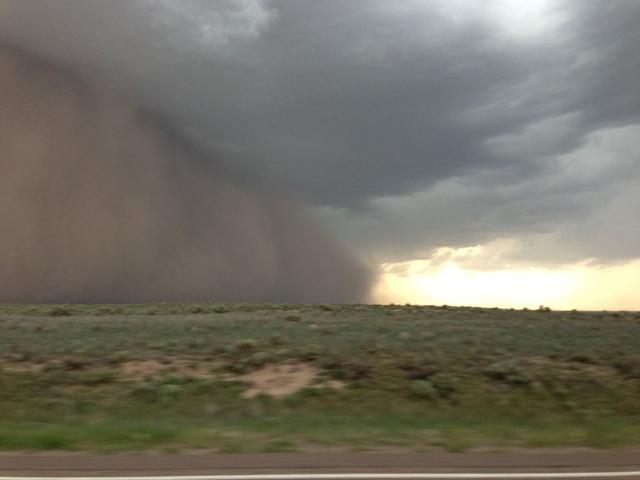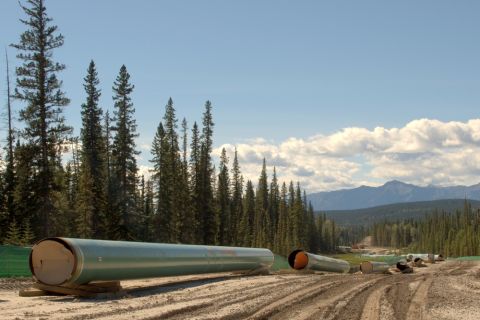
The Cheyenne County, Colo., area is part of the great American dustbowl. (Source: TGS)
Advanced seismic processing can compensate for many common acquisition problems (and interpolation algorithms are being tested to fill small gaps where access is impossible), but high-quality data are still fundamentally reliant on skilled, well-planned management of the acquisition process. This means design and field operations teams must understand the project objectives and plan for the surface conditions as well as the geology to deliver high-quality data.
Colorado
TGS’ Cheyenne 3-D survey is located in southeast Colorado and encompasses a large portion of Cheyenne and Tioga counties with one small town, Kit Carson (population 238). The terrain is flat and arid, and vegetation and population are sparse. This area was part of the great American dustbowl, so securing surface sediments has become crucial for landowners in planning for the inevitable drought years. Roads are straight, and one can travel across the entire 3-D project in minutes even though it is almost 1,813 sq km (700 sq miles) in size.
Acquiring seismic in this area is relatively straightforward Vibroseis work. A Sercel cabled system with full GPS surveying was ideal for this terrain. There are few fences or obstacles to hinder progress, and weather usually cooperates with its classic Colorado blue skies.
TGS acquired the Cheyenne 3-D survey in 2013 to 2014, and it took 10 months, including all front-end permitting and surveying. There were 412 landowners that were permitted. The average size tract of land per landowner was 1,084 acres, or 4.3 sq km (1.69 sq miles). The recording crews took six months to complete the acquisition of the data.
The surface terrain might be boring to some, but the subsurface tells a different tale. The Cheyenne 3-D survey is situated on a subsurface structure known as the Las Animas Arch (Figure 1). This is a broad anticlinal uplift extending northeast-southwest and separating the Denver Basin from the Hugoton embayment of southeast Colorado. The stratigraphic section ranges from lower Paleozoic to Tertiary. The Pennsylvanian Morrow sands and the Mississippian Spergen limestones are prolific oil and gas zones in the region, with production from structural and stratigraphic traps.

FIGURE 1. The top image shows the Cheyenne 3-D survey’s prestack time migration. The west-east section shows basement faulting and salt dissolution. The right inset shows a seismic display with Mississippian-age structure contour, wells and time slice, while the left inset shows arid grasslands and relatively flat topography in Cheyenne County, Colo. (Source: TGS)
The Las Animas Arch experienced two episodes of deformation. Major fault zones from late Mississippian and Laramide-age deformational events set up numerous traps, and fault offsets at depth can exceed 46 m (150 ft).
Intervals of evaporates, including halite and anhydrite, are present in the Permian within the boundary of the Cheyenne seismic survey. These include the Blaine and the Stone Corral. A major Blaine salt dissolution edge trending north-south across the Cheyenne survey is clearly imaged on seismic. This dissolution edge, combined with the significant throws on Laramide-age faults, creates substantial localized deformation of originally flat-lying beds and significant challenges in processing the 3-D seismic data.
Ohio
Unlike southeast Colorado, acquiring seismic data in Ohio is challenging. TGS acquired the 1,818-sq-km (702-sq-mile) Freeport 3-D survey in 2014 to 2015. Front-end permitting operations, along with surveying and drilling, started nine months prior to the recording crew’s arrival. In contrast to the 412 land permits in Cheyenne, there were 16,789 landowners populating 42 municipalities within the Freeport project. The average- size tract of land per landowner was 27 acres/.10 sq km (.04 sq miles) vs. 1,084 acres in Colorado.
The acquisition timeline also was significantly greater than the Cheyenne 3-D survey because of the different terrain. Southeast Ohio is largely densely wooded and hilly, with some very steep slopes and tight populated valleys. The area is unglaciated, and the topography is the result in part of differential erosion of the mostly Pennsylvanian-Permian strata comprising sandstones, shales and coal seams. The winding, hilly roads meant more than two hours to drive the 80-km (50-mile) length of the project. Although Freeport was more populated, the field operations were remote due to the long and slow access required. The area lacked good cell and GPS signal coverage, and therefore TGS had to survey some areas with inertial survey systems. Creeks, rivers and five large lakes compounded the acquisition challenges. Vibroseis and dynamite sources were required, and TGS chose the FairfieldNodal cableless receiver system to acquire the data because of its flexibility in this type of environment. TGS used hydrophones and marsh phones in all of the lakes. The recording crews took more than 11 months to complete the acquisition. There were many logistical and HSE challenges with managing more than 300 people involved in permitting, mapping of large amounts of new oilfield infrastructure, surveying, drilling, recording, Vibroseis operations, peak particle velocity monitoring, helicopter operations, boat operations on the lakes, water well testing and overall quality control.
Freeport 3-D, along with Firestone and Waterford 3-D, were acquired over the prolific Utica unconventional oil and gas trend. In the subsurface the Freeport 3-D area is relatively undeformed, with the sedimentary section dipping gently eastward into the leading thrust faults of the Blue Ridge Mountains. Productive zones include the Lower Silurian Clinton sands, the Ordovician and the Upper Cambrian. The Ordovician Point Pleasant is the primary source rock as well as the primary unconventional target.
Figure 2 illustrates the subtle character of the structural deformation along the trend. Northwest-trending basement faults are clearly imaged, with late movement affecting much of the sedimentary section. Minor faulting is present, and seismic attribute tests suggest varying stress fields in the reservoir units.

FIGURE 2. The top image shows the Freeport 3-D survey’s prestack time migration in the northwest-southeast section. A number of regional basement faults are imaged in this section. Other than these features, deformation is subtle and perhaps sub-seismic in scale. The left inset shows how terrain and weather make for challenging field operations. The right inset displays a shot hole drill rig at Freeport. (Source: TGS)
Recommended Reading
Russia Orders Companies to Cut Oil Output to Meet OPEC+ Target
2024-03-25 - Russia plans to gradually ease the export cuts and focus on only reducing output.
BP Starts Oil Production at New Offshore Platform in Azerbaijan
2024-04-16 - Azeri Central East offshore platform is the seventh oil platform installed in the Azeri-Chirag-Gunashli field in the Caspian Sea.
Imperial Expects TMX to Tighten Differentials, Raise Heavy Crude Prices
2024-02-06 - Imperial Oil expects the completion of the Trans Mountain Pipeline expansion to tighten WCS and WTI light and heavy oil differentials and boost its access to more lucrative markets in 2024.
What's Affecting Oil Prices This Week? (Feb. 5, 2024)
2024-02-05 - Stratas Advisors says the U.S.’ response (so far) to the recent attack on U.S. troops has been measured without direct confrontation of Iran, which reduces the possibility of oil flows being disrupted.
McKinsey: US Output Hinges on E&P Capital Discipline, Permian Well Trends
2024-02-07 - U.S. oil production reached record levels to close out 2023. But the future of U.S. output hinges on E&P capital discipline and well-productivity trends in the Permian Basin, according to McKinsey & Co.



